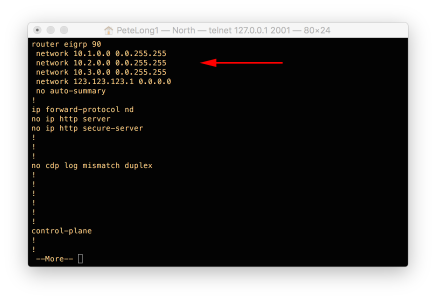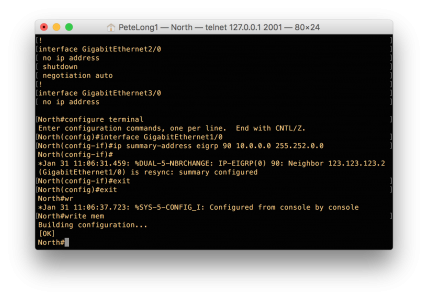KB ID 0001149
Problem
I’ve already written a post that lets you calculate a route summarisation. So now you have a method of advertising your routes more efficiently, what do you do with it? Well I’m at the EIGRP point in my studies so here’s how to implement it with EIGRP.
To demonstrate I’ve built the above network on GNS3, there is a loopback interface on the routers for each of those networks.
Solution
I’ve already setup EIGRP, and importantly disabled auto-summarisation* If we take a look at the routing table on the North router we can see the routes being learned from the South router;
*Note: If this exercise is about summarisation, why have I disable auto-summarisation? Well if I didn’t the routers would see all the remote subnets as 10.0.0.0/8 and nothing would work!
And you will see the ‘opposite’ in the routing table on the South router;
And just to prove it’s not all smoke and mirrors, here’s the current EIGRP config on both routers;
Now you actually apply the route summarisation on the network interface that the routes are getting advertised through (even through the IP of that network may not be in the networks you are summarising). This may seem a little odd that it’s not done in the ‘router eigrp {system number}’ part of the config. My routers both connect to each other with their GigiabitEthernet1/0 interface.
Firstly, perform your route summarisation, and you should come up with 10.0.0.0/14 for the North router and 10.4.0.0/14 on th South router.
Apply the route summarisation on the GE1/0 interface;
interface GigabitEthernet1/0 ip summary-address eigrp 90 10.0.0.0 255.252.0.0
If you are wondering /14 is 255.252.0.0, I struggle to remember converting short and long notation subnets, that’s why I’ve got an IP subnet aide memoir.
Now configure the South router;
interface GigabitEthernet1/0
ip summary-address eigrp 90 10.4.0.0 255.252.0.0Now if you look on the routing tables of both routers, you will see the routes have been summarised.
Why is the summarised route listed twice? And why does one route point to Null0?
Well to get your head round this, you need to understand that ‘a more specific route always wins‘, e.g. traffic coming from the 10.1.0.0 subnet behind router North that is arriving at router South will have a subnet of /16 (or /32), which is more specific than the /14 summarised route. OK, but Null0 drops the traffic? So lets say all the remote networks in the North Site ‘Go Down’. The South, route now only has the 10.0.0.0/14 route left, so it would drop the traffic, which is good as those subnets are all down.
Related Articles, References, Credits, or External Links
Network Summarisation – Exam Technique and Examples
Cisco Router IOS – Configuring EIGRP










